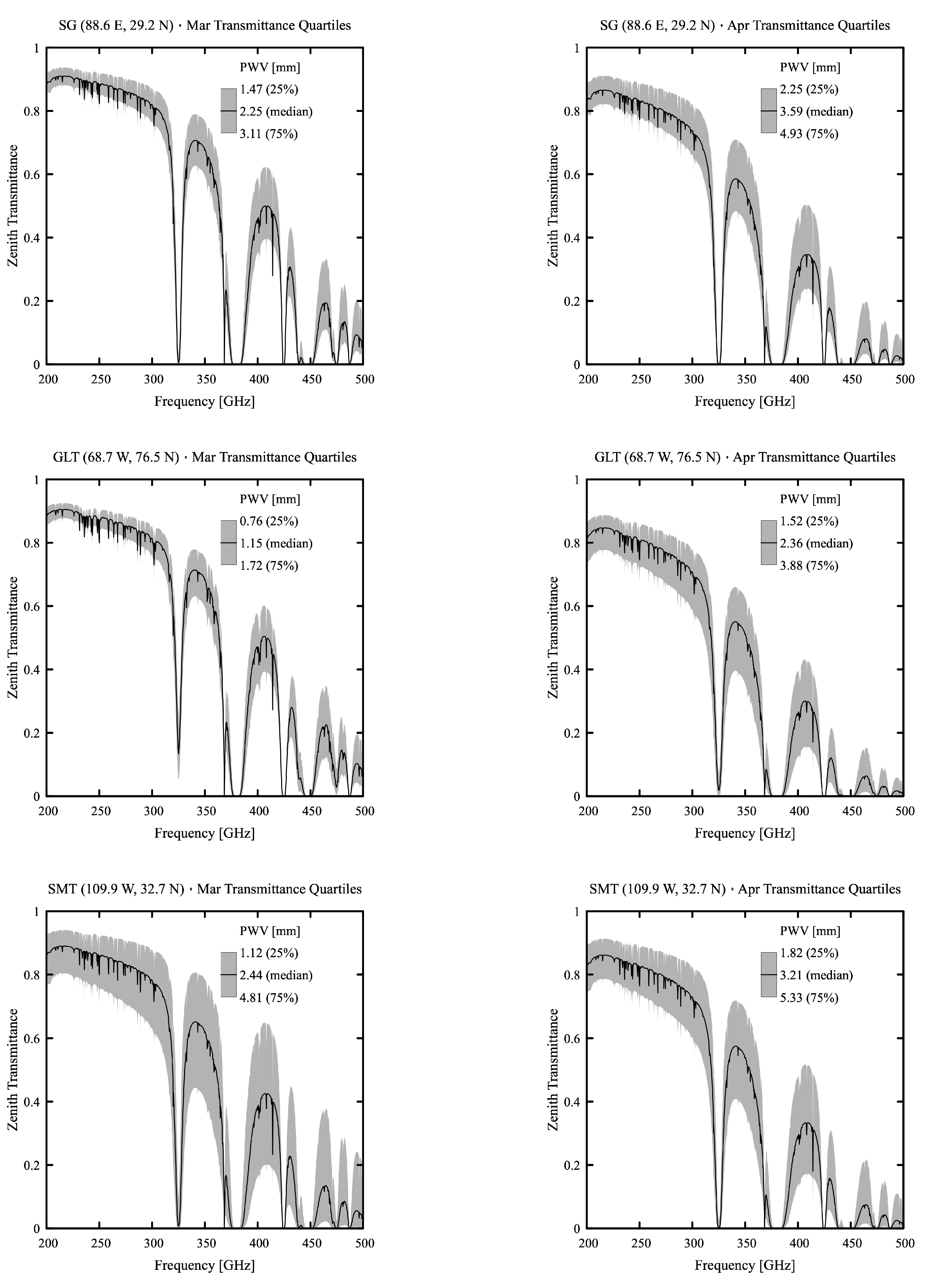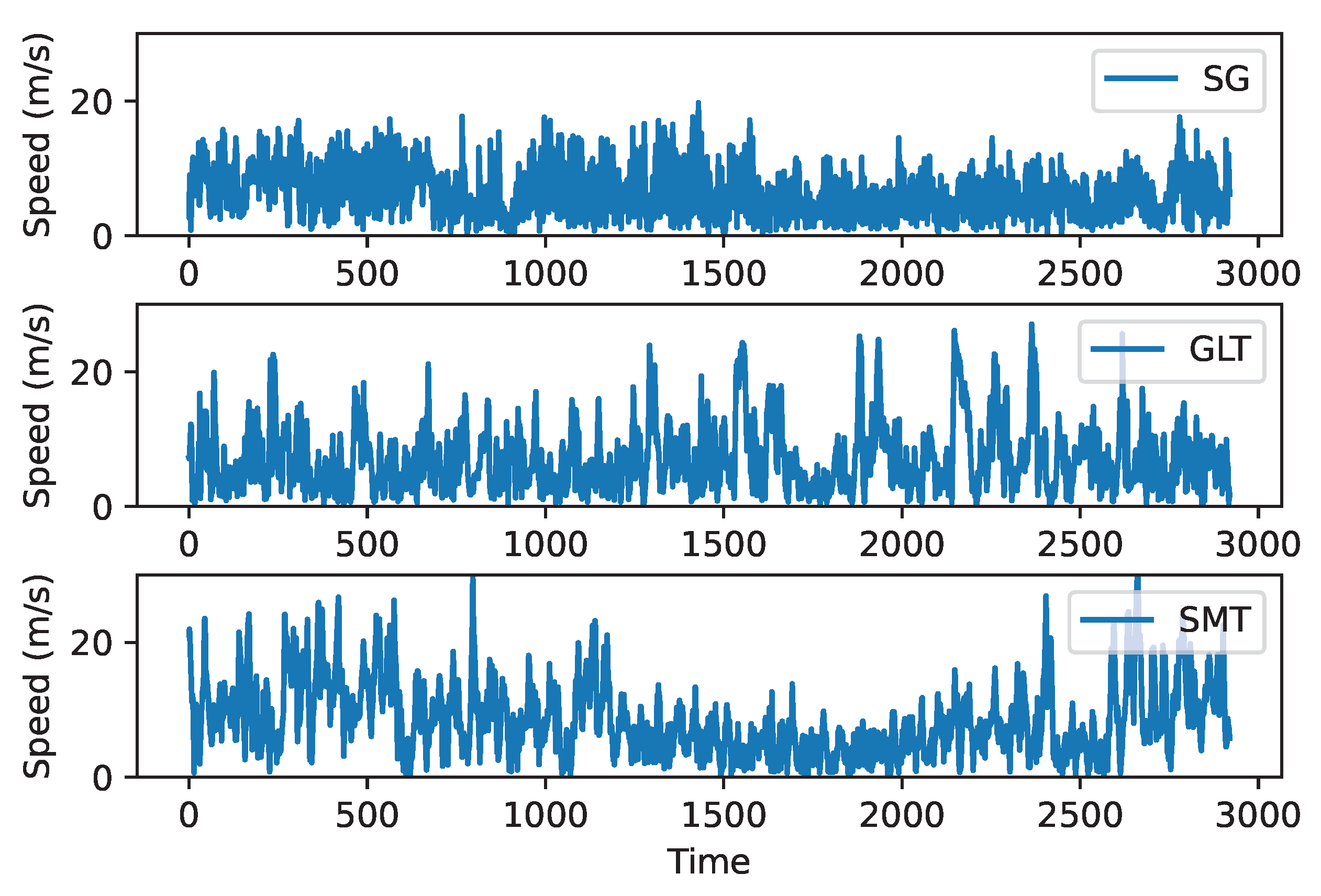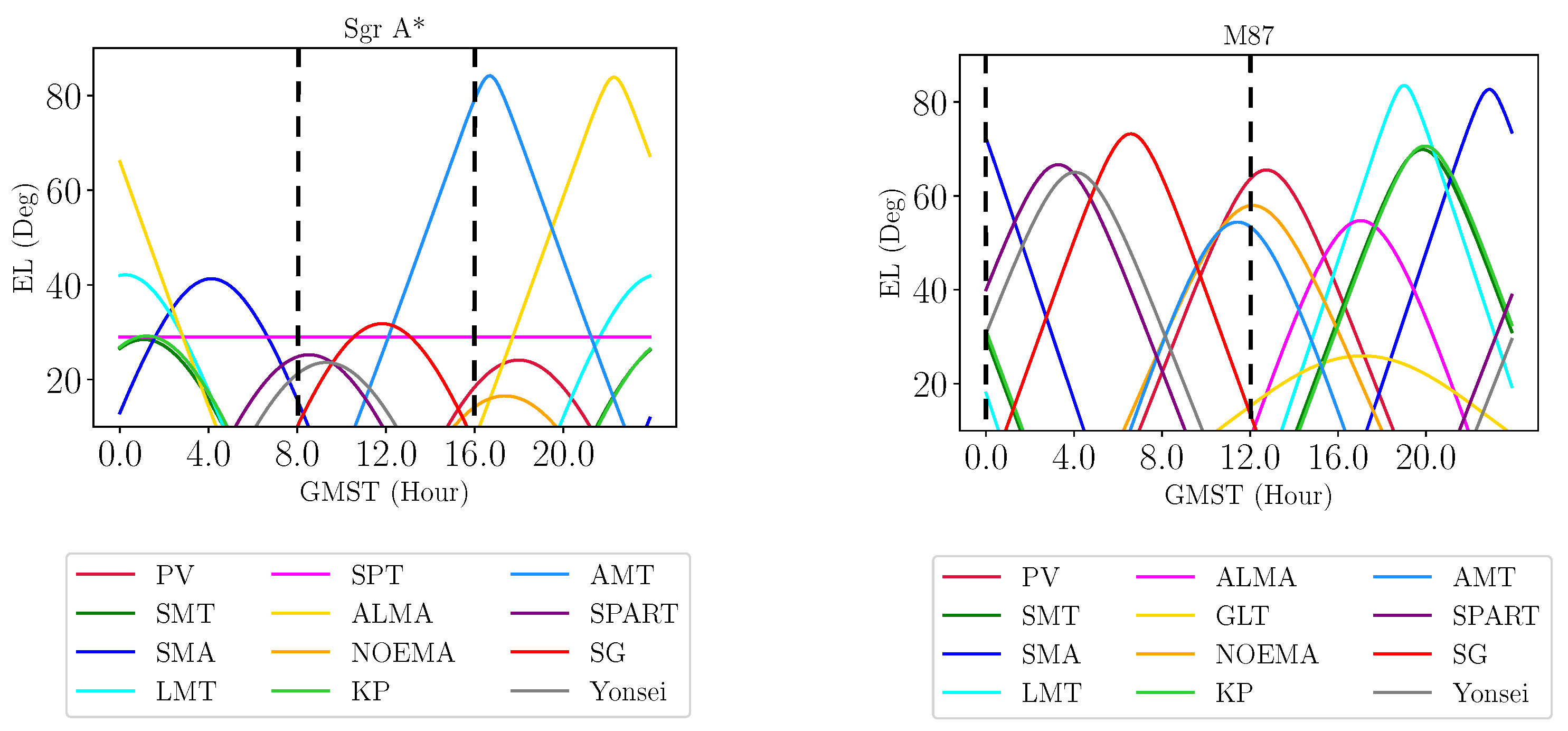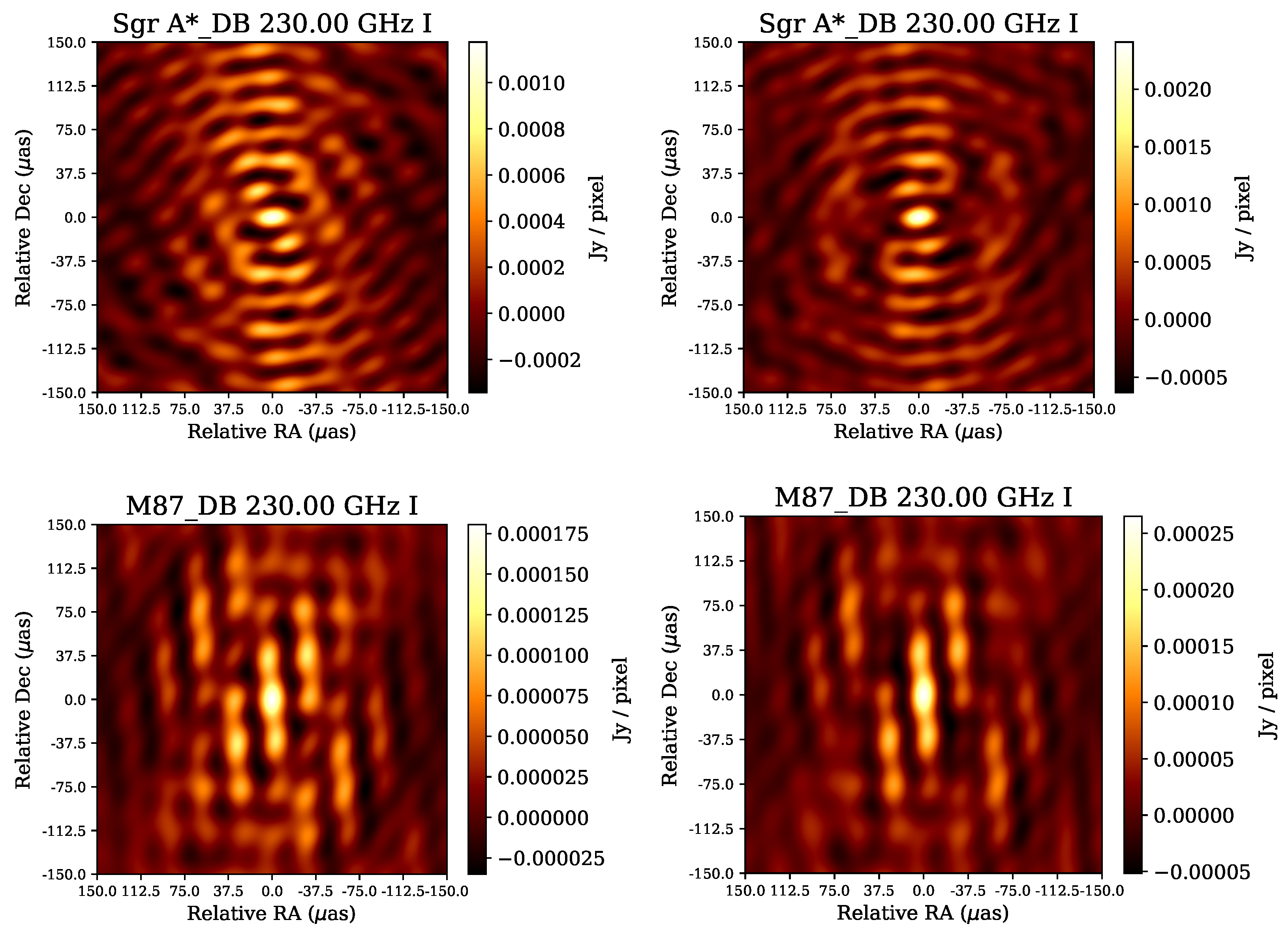Evaluation of a Candidate Site in the Tibetan Plateau towards the Next Generation Event Horizon Telescope
Abstract
:1. Introduction
2. Evaluation of Meteorological Conditions
3. Synthetic Data Generation and Imaging Method
4. Simulation Results and Discussion
4.1. Elevation and Visibility Coverage
4.2. Imaging
5. Conclusions
Author Contributions
Funding
Institutional Review Board Statement
Informed Consent Statement
Data Availability Statement
Acknowledgments
Conflicts of Interest
References
- Event Horizon Telescope Collaboration; Akiyama, K.; Alberdi, A.; Alef, W.; Asada, K.; Azulay, R.; Baczko, A.K.; Ball, D.; Baloković, M.; Barrett, J.; et al. First M87 Event Horizon Telescope Results. I. The Shadow of the Supermassive Black Hole. Astrophys. J. Lett. 2019, 875, L1. [Google Scholar] [CrossRef]
- Event Horizon Telescope Collaboration; Akiyama, K.; Alberdi, A.; Alef, W.; Algaba, J.C.; Anantua, R.; Asada, K.; Azulay, R.; Bach, U.; Baczko, A.K.; et al. First Sagittarius A* Event Horizon Telescope Results. I. The Shadow of the Supermassive Black Hole in the Center of the Milky Way. Astrophys. J. Lett. 2022, 930, L12. [Google Scholar] [CrossRef]
- Doeleman, S.; Blackburn, L.; Dexter, J.; Gomez, J.L.; Johnson, M.D.; Palumbo, D.C.; Weintroub, J.; Farah, J.R.; Fish, V.; Loinard, L.; et al. Studying Black Holes on Horizon Scales with VLBI Ground Arrays. Bull. Am. Astron. Soc. 2019, 51, 256. [Google Scholar]
- Backes, M.; Müller, C.; Conway, J.E.; Deane, R.; Evans, R.; Falcke, H.; Fraga-Encinas, R.; Goddi, C.; Klein Wolt, M.; Krichbaum, T.P.; et al. The Africa Millimetre Telescope. In Proceedings of the 4th Annual Conference on High Energy Astrophysics in Southern Africa (HEASA 2016), Cape Town, South Africa, 25–26 August 2016; p. 29. [Google Scholar] [CrossRef] [Green Version]
- Asada, K.; Kino, M.; Honma, M.; Hirota, T.; Lu, R.S.; Inoue, M.; Sohn, B.W.; Shen, Z.Q.; Ho, P.T.P.; Akiyama, K.; et al. White Paper on East Asian Vision for mm/submm VLBI: Toward Black Hole Astrophysics down to Angular Resolution of 1∼RS. arXiv 2017, arXiv:1705.04776. [Google Scholar]
- Ye, Q.Z.; Su, M.; Li, H.; Zhang, X. Tibet’s Ali: Asia’s Atacama? Mon. Not. R. Astron. Soc. Lett. 2016, 457, L1–L4. [Google Scholar] [CrossRef] [Green Version]
- Gelaro, R.; McCarty, W.; Suárez, M.J.; Todling, R.; Molod, A.; Takacs, L.; Randles, C.A.; Darmenov, A.; Bosilovich, M.G.; Reichle, R.; et al. The Modern-Era Retrospective Analysis for Research and Applications, Version 2 (MERRA-2). J. Clim. 2017, 30, 5419–5454. [Google Scholar] [CrossRef] [PubMed]
- Paine, S. The Am Atmospheric Model. Zenodo. 2019. Available online: https://doi.org/10.5281/zenodo.3406483 (accessed on 8 December 2022).
- Paine, S. BH PIRE Winter School 2018 Tutorial: Radio Climatology. 2018. Available online: https://bhpire.arizona.edu/education/tutorials/ (accessed on 8 December 2022).
- Raymond, A.W.; Palumbo, D.; Paine, S.N.; Blackburn, L.; Córdova Rosado, R.; Doeleman, S.S.; Farah, J.R.; Johnson, M.D.; Roelofs, F.; Tilanus, R.P.J.; et al. Evaluation of New Submillimeter VLBI Sites for the Event Horizon Telescope. Astrophys. J. Suppl. Ser. 2021, 253, 5. [Google Scholar] [CrossRef]
- Event Horizon Telescope Collaboration; Akiyama, K.; Alberdi, A.; Alef, W.; Asada, K.; Azulay, R.; Baczko, A.K.; Ball, D.; Baloković, M.; Barrett, J.; et al. First M87 Event Horizon Telescope Results. II. Array and Instrumentation. Astrophys. J. Lett. 2019, 875, L2. [Google Scholar] [CrossRef]
- Event Horizon Telescope Collaboration; Akiyama, K.; Alberdi, A.; Alef, W.; Asada, K.; Azulay, R.; Baczko, A.K.; Ball, D.; Baloković, M.; Barrett, J.; et al. First M87 Event Horizon Telescope Results. III. Data Processing and Calibration. Astrophys. J. Lett. 2019, 875, L3. [Google Scholar] [CrossRef]
- Broderick, A.E.; Fish, V.L.; Doeleman, S.S.; Loeb, A. Evidence for Low Black Hole Spin and Physically Motivated Accretion Models from Millimeter-VLBI Observations of Sagittarius A*. Astrophys. J. 2011, 735. [Google Scholar] [CrossRef]
- Chael, A.; Narayan, R.; Johnson, M.D. Two-temperature, Magnetically Arrested Disc simulations of the jet from the supermassive black hole in M87. Mon. Not. R. Astron. Soc. 2019, 486, 2873–2895. [Google Scholar] [CrossRef]
- Chael, A.A. Simulating and Imaging Supermassive Black Hole Accretion Flows. Ph.D. Thesis, Harvard University, Cambridge, MA, USA, 2019. [Google Scholar]
- Jennison, R.C. A phase sensitive interferometer technique for the measurement of the Fourier transforms of spatial brightness distributions of small angular extent. Mon. Not. R. Astron. Soc. 1958, 118, 276. [Google Scholar] [CrossRef] [Green Version]
- Rogers, A.E.E.; Hinteregger, H.F.; Whitney, A.R.; Counselman, C.C.; Shapiro, I.I.; Wittels, J.J.; Klemperer, W.K.; Warnock, W.W.; Clark, T.A.; Hutton, L.K.; et al. The structure of radio sources 3C 273B and 3C 84 deduced from the “closure” phases and visibility amplitudes observed with three-element interferometers. Astrophys. J. 1974, 193, 293–301. [Google Scholar] [CrossRef]
- Lu, R.S.; Roelofs, F.; Fish, V.L.; Shiokawa, H.; Doeleman, S.S.; Gammie, C.F.; Falcke, H.; Krichbaum, T.P.; Zensus, J.A. Imaging an Event Horizon: Mitigation of Source Variability of Sagittarius A*. Astrophys. J. 2016, 817, 173. [Google Scholar] [CrossRef] [Green Version]
- Chael, A.A.; Johnson, M.D.; Narayan, R.; Doeleman, S.S.; Wardle, J.F.C.; Bouman, K.L. High-resolution Linear Polarimetric Imaging for the Event Horizon Telescope. Astrophys. J. 2016, 829, 11. [Google Scholar] [CrossRef]
- Akiyama, K.; Kuramochi, K.; Ikeda, S.; Fish, V.L.; Tazaki, F.; Honma, M.; Doeleman, S.S.; Broderick, A.E.; Dexter, J.; Mościbrodzka, M.; et al. Imaging the Schwarzschild-radius-scale Structure of M87 with the Event Horizon Telescope Using Sparse Modeling. Astrophys. J. 2017, 838, 1. [Google Scholar] [CrossRef]
- Akiyama, K.; Ikeda, S.; Pleau, M.; Fish, V.L.; Tazaki, F.; Kuramochi, K.; Broderick, A.E.; Dexter, J.; Mościbrodzka, M.; Gowanlock, M.; et al. Superresolution Full-polarimetric Imaging for Radio Interferometry with Sparse Modeling. Astrophys. J. 2017, 153, 159. [Google Scholar] [CrossRef] [Green Version]
- Chael, A.A.; Johnson, M.D.; Bouman, K.L.; Blackburn, L.L.; Akiyama, K.; Narayan, R. Interferometric Imaging Directly with Closure Phases and Closure Amplitudes. Astrophys. J. 2018, 857, 23. [Google Scholar] [CrossRef]
- Event Horizon Telescope Collaboration; Akiyama, K.; Alberdi, A.; Alef, W.; Asada, K.; Azulay, R.; Baczko, A.K.; Ball, D.; Baloković, M.; Barrett, J.; et al. First M87 Event Horizon Telescope Results. IV. Imaging the Central Supermassive Black Hole. Astrophys. J. Lett. 2019, 875, L4. [Google Scholar] [CrossRef]
- Event Horizon Telescope Collaboration; Akiyama, K.; Alberdi, A.; Alef, W.; Asada, K.; Azulay, R.; Baczko, A.K.; Ball, D.; Baloković, M.; Barrett, J.; et al. First M87 Event Horizon Telescope Results. VI. The Shadow and Mass of the Central Black Hole. Astrophys. J. Lett. 2019, 875, L6. [Google Scholar] [CrossRef]











| Telescope | Location | SEFD (Jy) | X (m) | Y (m) | Z (m) |
|---|---|---|---|---|---|
| SPART | Japan | 10,000 | −3,871,061.02 | 3,428,327.24 | 3,723,784.27 |
| Yonsei | Korea | 4428 | −3,042,280.91 | 4,045,902.72 | 3,867,374.35 |
| SG | China | 5200 | 92,309.877 | 5,566,822.809 | 3,109,831.733 |
| AMT | Namibia | 6000 | 5,627,857.426 | 1,638,239.676 | −2,512,266.994 |
| Data/Regularizer Terms | Weight (Round 1) | Weight (Round 2) | Weight (Rounds 3 and 4) |
|---|---|---|---|
| Visibility Amplitude () | 1 | 1 | 5 |
| Closure phase () | 10 | 1 | 2 |
| Log Closure Amplitude () | 10 | 1 | 2 |
| Entropy () | 10 | 10 | 10 |
|---|---|---|---|
| Total Variation () | 1 | 1 | 1 |
| Total squared variation () | 1 | 1 | 1 |
| Centroid Position () | 20 | 20 | 20 |
| Total Flux Density () | 100 | 100 | 100 |
Disclaimer/Publisher’s Note: The statements, opinions and data contained in all publications are solely those of the individual author(s) and contributor(s) and not of MDPI and/or the editor(s). MDPI and/or the editor(s) disclaim responsibility for any injury to people or property resulting from any ideas, methods, instructions or products referred to in the content. |
© 2022 by the authors. Licensee MDPI, Basel, Switzerland. This article is an open access article distributed under the terms and conditions of the Creative Commons Attribution (CC BY) license (https://creativecommons.org/licenses/by/4.0/).
Share and Cite
Yu, W.; Lu, R.-S.; Shen, Z.-Q.; Weintroub, J. Evaluation of a Candidate Site in the Tibetan Plateau towards the Next Generation Event Horizon Telescope. Galaxies 2023, 11, 7. https://doi.org/10.3390/galaxies11010007
Yu W, Lu R-S, Shen Z-Q, Weintroub J. Evaluation of a Candidate Site in the Tibetan Plateau towards the Next Generation Event Horizon Telescope. Galaxies. 2023; 11(1):7. https://doi.org/10.3390/galaxies11010007
Chicago/Turabian StyleYu, Wei, Ru-Sen Lu, Zhi-Qiang Shen, and Jonathan Weintroub. 2023. "Evaluation of a Candidate Site in the Tibetan Plateau towards the Next Generation Event Horizon Telescope" Galaxies 11, no. 1: 7. https://doi.org/10.3390/galaxies11010007






